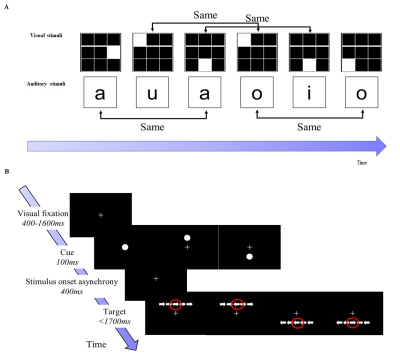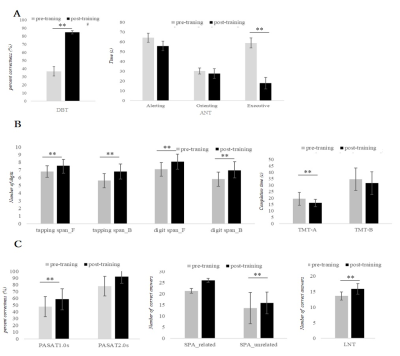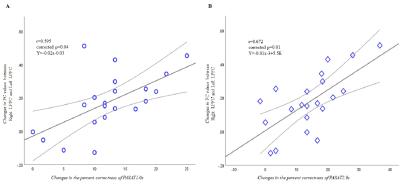1238
Combined Working Memory and Attention Training Improves Cognition via Task-Specific and Transfer Effects
Daisuke Sawamura1,2, Ryusuke Suzuki3, Keita Ogawa4, Shinya Sakai2, Xinnan Li1, Hiroyuki Hamaguchi1, and Khin Khin Tha5,6
1Department of Biomarker Imaging Science, Graduate School of Biomedical Science and Engineering, Hokkaido University, Sapporo, Japan, 2Department of Functioning and Disability, Faculty of Health Sciences, Hokkaido University, Sapporo, Japan, 3Departments of Medical Physics, Hokkaido University Hospital, Sapporo, Japan, 4Department of Rehabilitation, Hokkaido University Hospital, Sapporo, Japan, 5Department of Diagnostic and Interventional Radiology, Hokkaido University, Sapporo, Japan, 6Global Station for Quantum Medical Science and Engineering, Hokkaido University, Sapporo, Japan
1Department of Biomarker Imaging Science, Graduate School of Biomedical Science and Engineering, Hokkaido University, Sapporo, Japan, 2Department of Functioning and Disability, Faculty of Health Sciences, Hokkaido University, Sapporo, Japan, 3Departments of Medical Physics, Hokkaido University Hospital, Sapporo, Japan, 4Department of Rehabilitation, Hokkaido University Hospital, Sapporo, Japan, 5Department of Diagnostic and Interventional Radiology, Hokkaido University, Sapporo, Japan, 6Global Station for Quantum Medical Science and Engineering, Hokkaido University, Sapporo, Japan
Synopsis
Little is known about how neurocognition is modulated upon combined computerized cognitive training (CCT). We developed a combined CCT program designed to improve several cognitive functions simultaneously, and evaluated its effect on neurocognitive performance and functional connectivity (FC) of the brain. The results suggest that the CCT improves not only the targeted functions but also the other aspects of neurocognition via augmentation of transfer effect. The LPFC and fronto-parieto-occipital networks are thought to play role.
INTRODUCTION
Previous studies have shown that computerized cognitive training (CCT) targeted at a specific cognitive function such as attention can also improve other cognitive functions such as general intelligence, via near and far-transfer effects. Of the CCT programs, combined CCT is designed to improve several cognitive functions simultaneously. However, only a few studies1,2 have reported about the effectiveness of combined CCT, and it is not known whether the transfer effect is augmented. We developed a combined CCT program designed to improve working memory and attention training (CCTwm+at), and evaluated its effect on neurocognitive performance and functional connectivity (FC) of the brain.METHODS
This prospective study was approved by a local ethical committee, and written informed consent was obtained from all participants. Altogether 29 healthy subjects were included in this study. Each participant was assigned to either the training group or the control group. The training group included 21 subjects (mean age = 27.7 ± 6.0 years, 9 women) and the control group 8 age, gender, and education level-matched subjects (mean age = 31.5 ± 9.5 years, 4 women). All participants underwent a set of neuropsychological tests and resting state functional MRI (rsfMRI) (TR/TE = 3000/30 ms, voxel size = 3.75 × 3.75 × 3.75mm3, 140 dynamic sessions) twice within a six-week period (Figure 1). The neuropsychological tests consisted of 13 tasks designed to reflect task-specific (2 tests), near-transfer (6 tests), and far-transfer (5 tests) effects of the assigned tasks. The rsfMRI data were used to identify the brain voxels which are functionally connected to the salience, dorsal attention, fronto-parietal and default mode networks and the strength of connection in between in terms of functional connectivity (FC). The training group additionally underwent an hour-long CCTwm+at, which included dual n-back task (DBT) and attention network task (ANT) (Figure 2), five days a week for four weeks, during the period. The effectiveness of the CCTwm+at was evaluated by comparing the neuropsychological performance as evaluated by the aforementioned neuropsychological tests and FC between the two groups, by using two-way mixed-design ANOVA. The effect size (Cohen’s d) was calculated to identify the magnitude of difference in neuropsychological performance between the trained and control groups and before and after CCT in the training group. The change in neuropsychological performance and that in FC upon CCT were tested for correlation, by using Pearson’s product-moment correlation analyses.RESULTS
Neuropsychological performance improved significantly after CCTwm+at in the training group, which was evident in 11 of 13 tasks evaluated (Figure 3). The effect sizes for the performance of neuropsychological tests which evaluated the transfer effect were 0.36 -1.55 and 0.00 - 0.12 in the trained group and the control group, respectively. Those for the training group before and after CCT were 0.08 - 0.41 and 0.43 - 1.70, respectively. FC between the right lateral prefrontal cortex (LPFC) and the left LPFC or the right lingual gyrus also increased after CCT (FWE corrected P<0.05) (Figure 4). The changes in percent correctness of Paced Auditory Serial Addition Task (PASAT) 1.0 and 2.0 s showed significant moderate to strong positive correlation with the change in FC between the right (r=0.595, corrected P=0.04) and left LPFC (r=0.672, corrected P=0.01) (Figure 5).DISCUSSION
Improved neuropsychological performance, not only in the assigned tasks but also those tasks which involve the transfer effect, implies that the combined CCT also improves neurocognition via near and far-transfer effects. The observation of larger effect sizes for tests which evaluate the transfer effect, compared to those achieved by CCT targeted at a specific cognitive function (0.3-0.7 and 0.3-0.5 for single working memory training3 and single attention training4, respectively), is thought to imply augmentation of the transfer effect with combined CCT. Increased FC in the designated brain areas is thought to suggest the role of particular brain networks in modulating cognition. Our observations are in good alignment with previous reports5,6. Neural connections between the bilateral LPFC have been linked to working memory. Neural connections between the LPFC and lingual gyrus form the fronto-parieto-occipital network, which is known to play an important role in top-down drive of attention and short-term memory maintenance6. The correlation between the changes in percent correctness of PASAT and the FC changes between the right and left LPFC may suggest that the far-transfer effect of CCTwm+at occurs through modification of FC between these areas. FC between bilateral LPFC has been reported as reflective of cognitive functions such as attention and working memory5,7.CONCLUSIONS
The effect of combined CCT on neurocognitive performance and FC of the brain was evaluated. Combined CCT improves not only the targeted functions but also the other aspects of neurocognition via augmentation of transfer effect. The LPFC and fronto-parieto-occipital networks are thought to involve in modulation of neurocognition associated with combined CCT.Acknowledgements
This study was supported by the Grant-in-Aid for scientific research by the Japan Society for Promotion of Science (Grant Number JP19K11317).
References
- Sandberg P et al. Long-term effects of executive process training in young and old adults. Neuropsychol Rehabil. 2016; 26: 761-782.
- Lovden M et al. Experience-dependent plasticity of white-matter microstructure extends into old age. Neuropsychologia. 2010; 48: 3878–3883.
- Heinzel et al. Neural correlates of training and transfer effects in working memory in older adults. NeuroImage 2016; 134: 236-249.
- Rolle CE et al. Enhancing Spatial Attention and Working Memory in Younger and Older Adults. Cogn Neurosci. 2017; 299:1483-1497.
- Takeuchi H, Taki Y, Nouchi R, Hashizume H, Sekiguchi A et al. Effects of working memory training on functional connectivity and cerebral blood flow during rest. Cortex. 2013; 49: 2106-2125.
- Kundu B, Chang JY, Postle BR, Van Veen BD. Context-specific differences in fronto-parieto-occipital effective connectivity during short-term memory maintenance. Neuroimage. 2015 ;114: 320-327.
- Sala-Llonch R et al. Brain connectivity during resting state and subsequent working memory task predicts behavioural performance. Cortex. 2012; 48: 1187-1196.
Figures
Figure 1: A summary of the study
design. All participants underwent a set of neuropsychological tests and rsfMRI
twice within a six-week period. The training group also underwent CCTwm+at.

Figure 2. The components of the CCT. A. Dual N-back task (DBT). DBT is a working memory task that
presents a series of visual and auditory stimuli in order. The participant
answers whether the current stimulus is the same as the stimulus presented n
times before. One of the five Japanese kana characters (‘a’, ‘i’, ‘u’, ‘e’,
‘o’) is randomly presented as auditory stimuli. B. Attention Network Task
(ANT). ANT is an attention task which requires the participant to answer the
direction of the center arrow appearing on the screen as quickly as possible.

Figure 3. Neuropsychological performance before and after CCT in
the training group. Significant improvements are observed in the tests that evaluate
the task-specific (A), near-transfer (B), and far-transfer (C) effects. *p <
0.01; **p < 0.001. Error bars indicate the standard error.
tapping span F: tapping span
forward, tapping span B: tapping span backward, TMT-A:Trail Making Test version A, TMT-B:Trail Making Test
version B, PASAT: Paced Auditory Serial Addition Task, SPA: Standard verbal
paired-associate learning test, LNT: Letter-Number Sequencing Test.

Figure 4. The change in FC upon CCT. The brain voxels which are functionally connected to the 19
regions which belong to the salience, dorsal attention, fronto-parietal and
default mode networks (A) are identified, by using a two-way mixed-design
ANOVA. FC between the right LPFC seed (shown in red) and the left LPFC
(MNI coordinate x= -30, y= -34, z= 24, Cluster size = 240 voxels) and right
lingual gyrus (x= 40, y= -62, z= 1, Cluster size = 141 voxels) increases upon
CCT (FWE corrected P<0.05), as shown in B (the glass brain display) and C
(significant clusters on a T1-weighted image template).

Figure 5. Scatterplots showing significant
moderate to strong positive correlations of the change in percent correctness
of PASAT 1.0 s (A) and PASAT 2.0 s (B) with FC between bilateral LPFC
(Bonferroni-corrected P< 0.05).